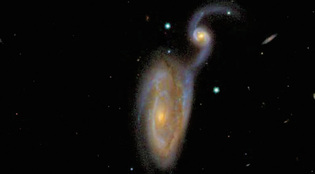 loading
loading
FindingsClassifying the cosmos Sloan Digital Sky SurveyView full imageLook hard at the galaxy in the photograph. See anything odd about it? A computer might recognize that NGC 5395 is a spiral. But it would probably miss something crucial: this galaxy has a companion. "A human observer would spot this right away," says Kevin Schawinski, a postdoctoral researcher in astronomy. "Our brains can see things a computer can't." Two years ago, Schawinksi, then a graduate student at Oxford, and a few of his colleagues figured out a way to put this human talent to work. The Sloan Digital Sky Survey had amassed an image collection of nearly a million galaxies in about one quarter of the Northern Hemisphere sky. But researchers had been able to examine and categorize only a small fraction. "One night in a pub, we came up with an idea: put the images on the Internet and see if we could get people to help us," says Schawinski. They thought public interest would be relatively limited. "Within 24 hours, we had melted a server." Thus was born Galaxy Zoo, a citizen-science project open to anyone with a computer, an Internet connection, and a fascination with outer space. So far, nearly 200,000 people have taken the ten-minute tutorial and signed up for the Zoo, now in its second phase. "We've found that the average person is as good at this as any professional astronomer," says Schawinski.
The comment period has expired.
|
|